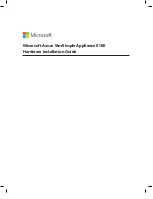
Default RADIUS Configuration
RADIUS and AAA are disabled by default.
To prevent a lapse in security, you cannot configure RADIUS through a network management application.
When enabled, RADIUS can authenticate users accessing the switch through the CLI.
RADIUS Server Host
Switch-to-RADIUS-server communication involves several components:
•
Hostname or IP address
•
Authentication destination port
•
Accounting destination port
•
Key string
•
Timeout period
•
Retransmission value
You identify RADIUS security servers by their hostname or IP address, hostname and specific UDP port
numbers, or their IP address and specific UDP port numbers. The combination of the IP address and the UDP
port number creates a unique identifier, allowing different ports to be individually defined as RADIUS hosts
providing a specific AAA service. This unique identifier enables RADIUS requests to be sent to multiple
UDP ports on a server at the same IP address.
If two different host entries on the same RADIUS server are configured for the same service
—
for example,
accounting
—
the second host entry configured acts as a fail-over backup to the first one. Using this example,
if the first host entry fails to provide accounting services, the %RADIUS-4-RADIUS_DEAD message appears,
and then the switch tries the second host entry configured on the same device for accounting services. (The
RADIUS host entries are tried in the order that they are configured.)
A RADIUS server and the switch use a shared secret text string to encrypt passwords and exchange responses.
To configure RADIUS to use the AAA security commands, you must specify the host running the RADIUS
server daemon and a secret text (key) string that it shares with the switch.
The timeout, retransmission, and encryption key values can be configured globally for all RADIUS servers,
on a per-server basis, or in some combination of global and per-server settings.
RADIUS Login Authentication
To configure AAA authentication, you define a named list of authentication methods and then apply that list
to various ports. The method list defines the types of authentication to be performed and the sequence in which
they are performed; it must be applied to a specific port before any of the defined authentication methods are
performed. The only exception is the default method list. The default method list is automatically applied to
all ports except those that have a named method list explicitly defined.
A method list describes the sequence and authentication methods to be queried to authenticate a user. You
can designate one or more security protocols to be used for authentication, thus ensuring a backup system for
authentication in case the initial method fails. The software uses the first method listed to authenticate users;
if that method fails to respond, the software selects the next authentication method in the method list. This
process continues until there is successful communication with a listed authentication method or until all
Consolidated Platform Configuration Guide, Cisco IOS Release 15.2(4)E (Catalyst 2960-X Switches)
905
Information about RADIUS
Summary of Contents for Catalyst 2960 Series
Page 96: ......
Page 196: ......
Page 250: ......
Page 292: ......
Page 488: ......
Page 589: ...P A R T VI Cisco Flexible NetFlow Configuring NetFlow Lite page 509 ...
Page 590: ......
Page 619: ...P A R T VII QoS Configuring QoS page 539 Configuring Auto QoS page 645 ...
Page 620: ......
Page 750: ......
Page 1604: ......
Page 1740: ......
Page 2105: ...P A R T XII Configuring Cisco IOS IP SLAs Configuring Cisco IP SLAs page 2025 ...
Page 2106: ......
Page 2118: ......
Page 2164: ......
















































